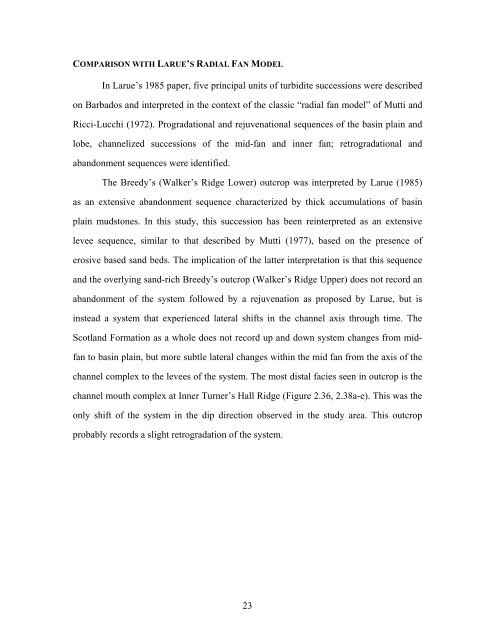Copyright by Nysha Chaderton 2009 - The University of Texas at ...
Copyright by Nysha Chaderton 2009 - The University of Texas at ...
Copyright by Nysha Chaderton 2009 - The University of Texas at ...
You also want an ePaper? Increase the reach of your titles
YUMPU automatically turns print PDFs into web optimized ePapers that Google loves.
COMPARISON WITH LARUE’S RADIAL FAN MODEL<br />
In Larue’s 1985 paper, five principal units <strong>of</strong> turbidite successions were described<br />
on Barbados and interpreted in the context <strong>of</strong> the classic “radial fan model” <strong>of</strong> Mutti and<br />
Ricci-Lucchi (1972). Prograd<strong>at</strong>ional and rejuven<strong>at</strong>ional sequences <strong>of</strong> the basin plain and<br />
lobe, channelized successions <strong>of</strong> the mid-fan and inner fan; retrograd<strong>at</strong>ional and<br />
abandonment sequences were identified.<br />
<strong>The</strong> Breedy’s (Walker’s Ridge Lower) outcrop was interpreted <strong>by</strong> Larue (1985)<br />
as an extensive abandonment sequence characterized <strong>by</strong> thick accumul<strong>at</strong>ions <strong>of</strong> basin<br />
plain mudstones. In this study, this succession has been reinterpreted as an extensive<br />
levee sequence, similar to th<strong>at</strong> described <strong>by</strong> Mutti (1977), based on the presence <strong>of</strong><br />
erosive based sand beds. <strong>The</strong> implic<strong>at</strong>ion <strong>of</strong> the l<strong>at</strong>ter interpret<strong>at</strong>ion is th<strong>at</strong> this sequence<br />
and the overlying sand-rich Breedy’s outcrop (Walker’s Ridge Upper) does not record an<br />
abandonment <strong>of</strong> the system followed <strong>by</strong> a rejuven<strong>at</strong>ion as proposed <strong>by</strong> Larue, but is<br />
instead a system th<strong>at</strong> experienced l<strong>at</strong>eral shifts in the channel axis through time. <strong>The</strong><br />
Scotland Form<strong>at</strong>ion as a whole does not record up and down system changes from mid-<br />
fan to basin plain, but more subtle l<strong>at</strong>eral changes within the mid fan from the axis <strong>of</strong> the<br />
channel complex to the levees <strong>of</strong> the system. <strong>The</strong> most distal facies seen in outcrop is the<br />
channel mouth complex <strong>at</strong> Inner Turner’s Hall Ridge (Figure 2.36, 2.38a-e). This was the<br />
only shift <strong>of</strong> the system in the dip direction observed in the study area. This outcrop<br />
probably records a slight retrograd<strong>at</strong>ion <strong>of</strong> the system.<br />
23
















